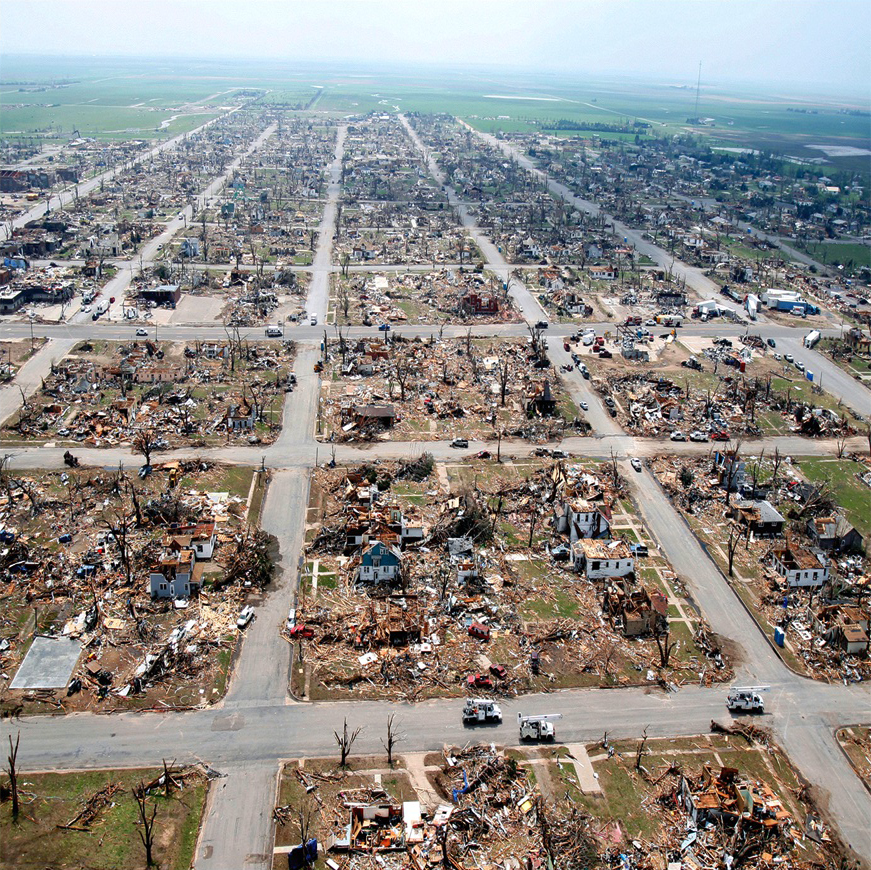
Chapter 1. Chapter 24: Sustainability
1.1 Introduction

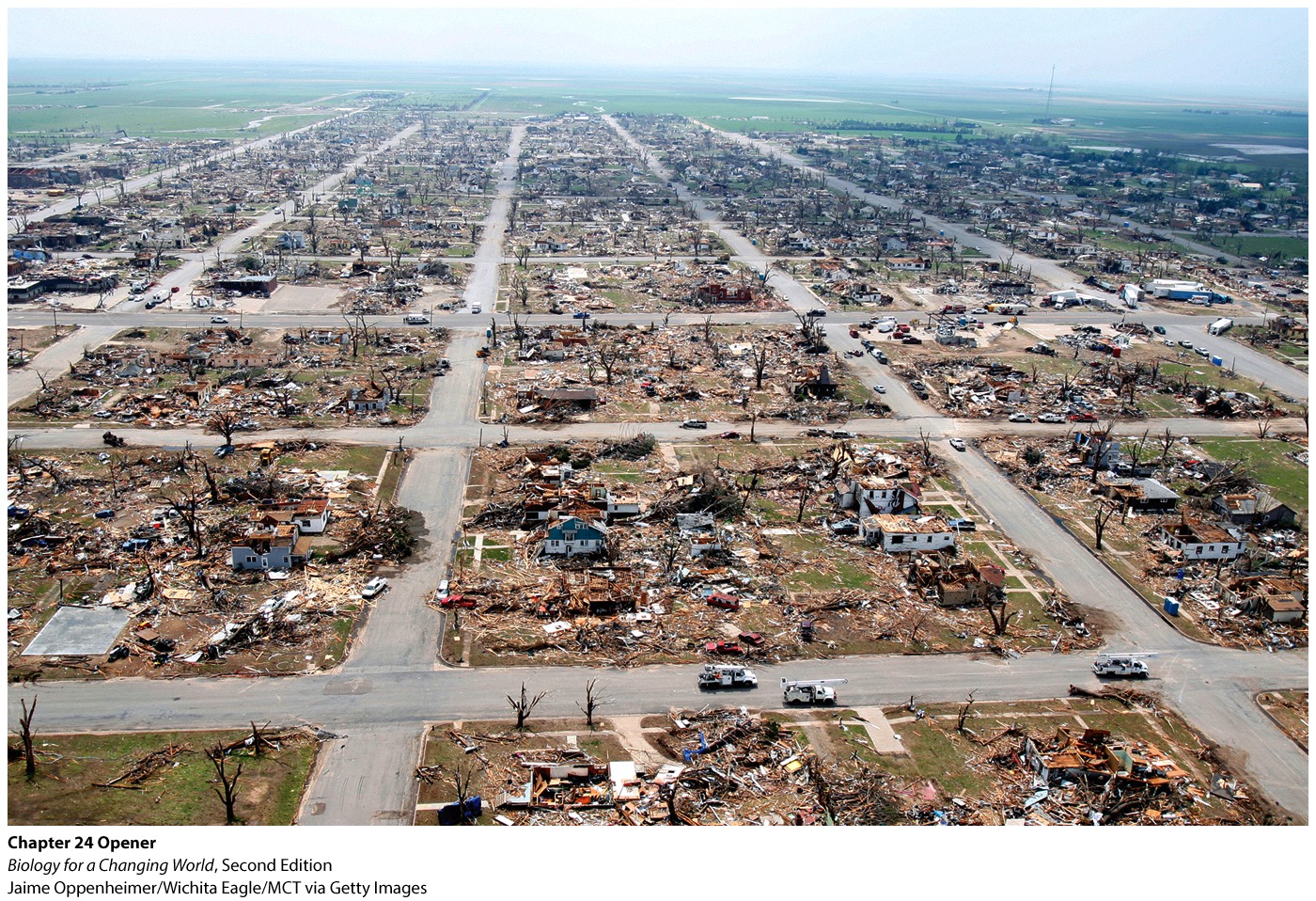
Welcome to the Interactive Study Guide for Chapter 24: Sustainability! This Study Guide will help you master your understanding of the chapter's Driving Questions, using interactive Infographics and activities, as well as targeted assessment questions. Click "Next" to get started, or select a Driving Question from the drop-down menu to the right.
The Makings of a Green City:
One Kansas town reinvents itself sustainable
DRIVING QUESTIONS
- What human impacts are considered when determining ecological footprint, and how does human population size influence our impact on Earth?
- What resources do humans rely on, and which of them are renewable?
- What is sustainable living?
1.2 Driving Question 1:
Driving Question 1
What human impacts are considered when determining ecological footprint, and how does human population size influence our impact on Earth?
Why should you care?
Sustainability, green, and eco-friendly are all becoming familiar words, but what do they mean, and should you really care? It is easy to believe that the recent ‘’“greenwashing” trend is a clever piece of marketing geared to sell products, especially because the scientific evidence is typically misconstrued, poorly disseminated, and/or concealed from the general public. The ecological footprint is a measure of how much an individual or a country draws upon the earth’s natural resources. Ecological footprints are usually measured in global hectares, the biocapacity of one hectare of productive land.
Simply put, humans are consuming more of the earth’s resources than can be replaced for future generations. Many resources that we use now are nonrenewable. That means that generations of the near future, if not our generation, may face shortages of essentials like clean water and energy.
Moreover, there is a global inequality in distribution of resources around the planet, with wealthy countries like the United States, which make up a minority of the world’s population, using a majority of the world’s resources. Wealthy nations, from a sense of fairness and sustainable use, should try to reduce consumption and pollution and narrow the gap.
What should you know?
To fully answer this Driving Question, you should be able to:
- Describe the actions that contribute to one’s ecological footprint.
- Explain how waste absorption also contributes to an individual’s ecological footprint.
- Describe how use of some resources contributes to the Earth’s biocapacity.
- Determine the national ecological footprint of countries, using their population size and their ecological footprint per capita.
- Describe the history and pattern of human population growth.
- Describe the correlation between human population growth and the decline or extinction of species.
Infographic Focus
The infographics most pertinent to the Driving Question are 24.1 to 24.3, 24.5, and 24.6.
Test Your Vocabulary
Choose the correct term for each of the following definitions:
| Term | Definition |
|---|---|
| A measure of how much land and water area is required to supply the resources an individual or a population consumes and to absorb the wastes it produces. | |
| Natural resources that cannot easily be replaced; fossil fuels are an example. | |
| The use of Earth’s resources in a way that will not permanently destroy or deplete them; living within the limits of Earth’s biocapacity. | |
| A unit of measurement representing the biological productivity (both resource-providing and waste-absorbing capacity) of an average hectare of Earth. | |
| The number of species and their relative abundances in a specific region or on the plant as a whole. | |
| The amount of Earth’s biologically productive area—cropland, pasture, forests, and fisheries—that is available to provide resources and absorb wastes to support life. | |
| Raw materials that are obtained from Earth and are considered valuable even in their relatively unmodified natural form. | |
| Natural resources that are replenished after use as long as the rate of consumption does not exceed the rate of replacement. |
Describe the actions that contribute to one’s ecological footprint.
1.

Examine the information presented in Infographic 24.1. Each of the categories that follow is a contributor to a person’s ecological footprint. Give an example for each category.
Consuming energy:
Keeping your food in a fridge, driving a car, turning on a light
2.
Using developed land:
3.
Using wood products:
4.
Eating certain foods:
Explain how waste absorption also contributes to an individual’s ecological footprint.
5.
In Questions 1-4, you listed ways you use certain resources. For the same categories, explain how use of that resource affects waste absorption by Earth, contributing to your ecological footprint.
Consuming energy:
6.
Using developed land:
7.
Using wood products:
8.
Eating certain foods:
Describe how use of some resources contributes to the Earth’s biocapacity.
9.
Describe how the use of the following resources is depleting the Earth’s natural resources or its ability to absorb waste.
Energy:
10.
Forest land:
11.
Fishes:
12.
Grazing land:
13.
Undeveloped land:
14.
Cropland:
Determine the national ecological footprint of countries, using their population size.
15.
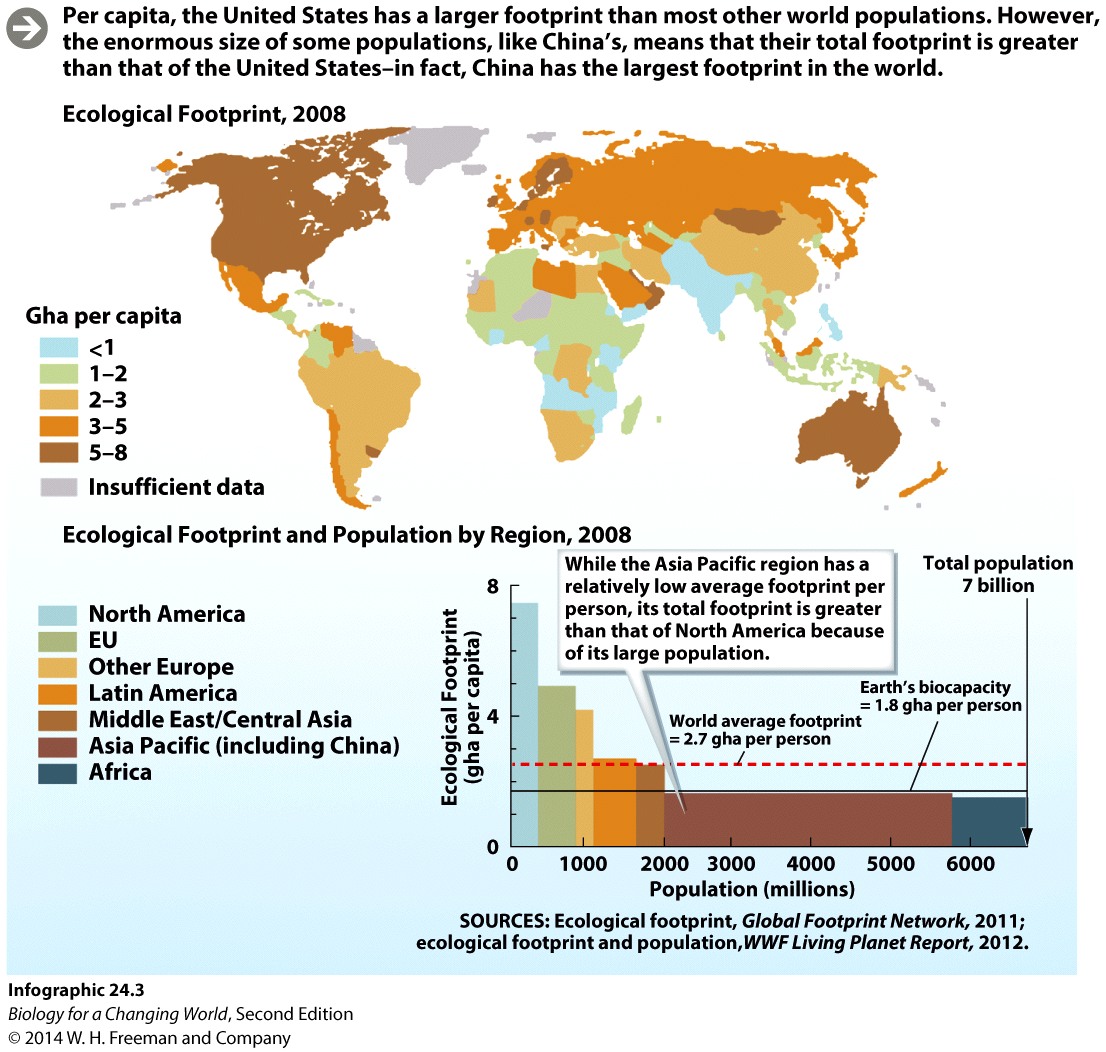
Examine the graph in Infographic 24.3 and answer the following questions.
Based on the information in the graph, which region of the world has the highest amount of global hectares per person?
North America
16.
Which region has the lowest amount of global hectares per person?
17.
Which region has the highest total ecological footprint? Why?
Describe the history and pattern of human population growth.
18.
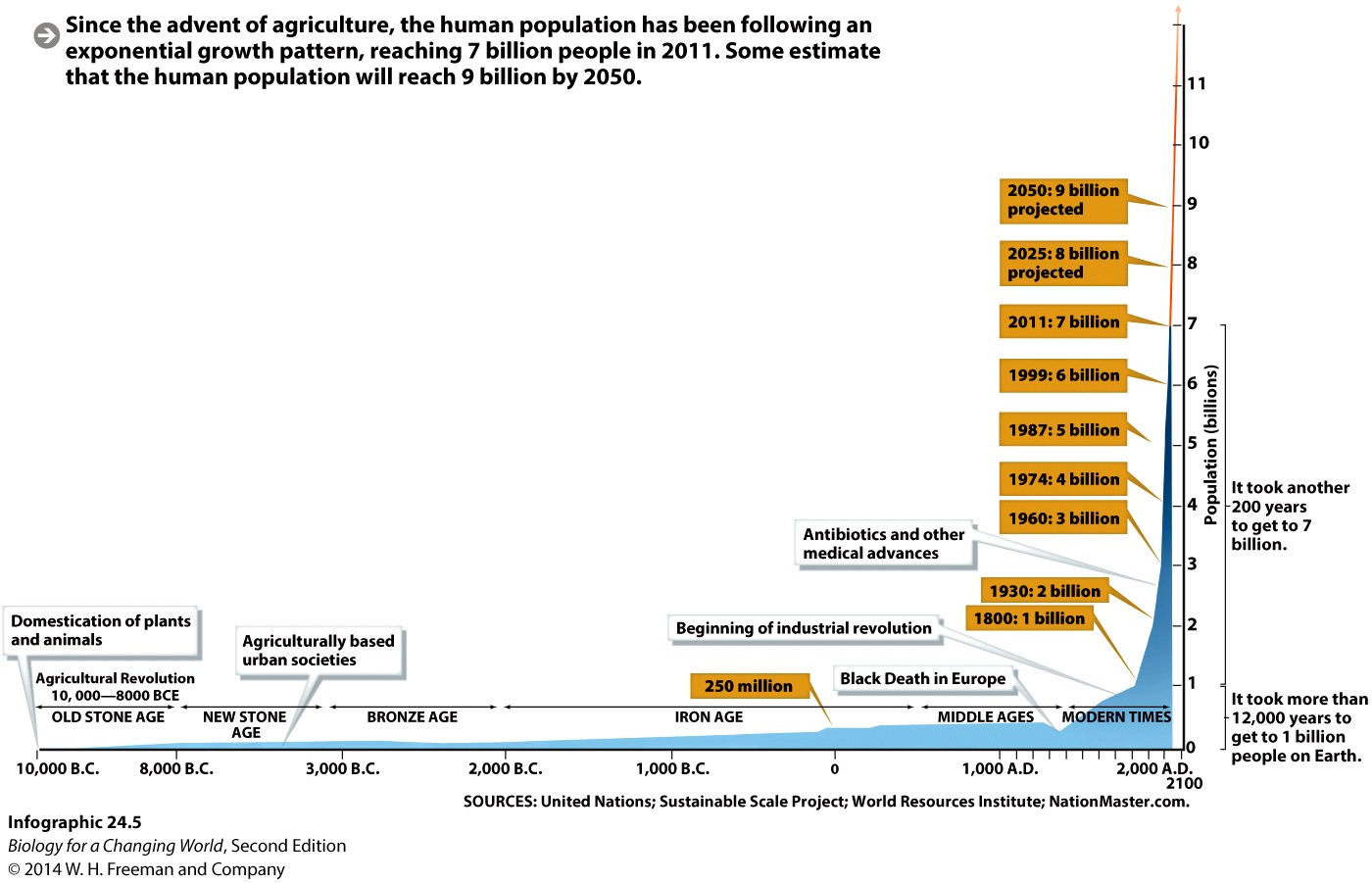
Answer the following questions based on the information in Infographic 24.5.
How long after the invention of agriculture did the human population reach 1 billion?
19.
How long did it take for the human population to grow from 1 billion to 2 billion?
20.
How long did it take for the human population to grow from 3 billion to 4 billion?
21.
How long did it take for the human population to grow from 6 billion to 7 billion?
22.
How long do you predict it will take for the human population to grow from 7 billion to 8 billion?
Describe the correlation between human population growth and the decline or extinction of species.
23.
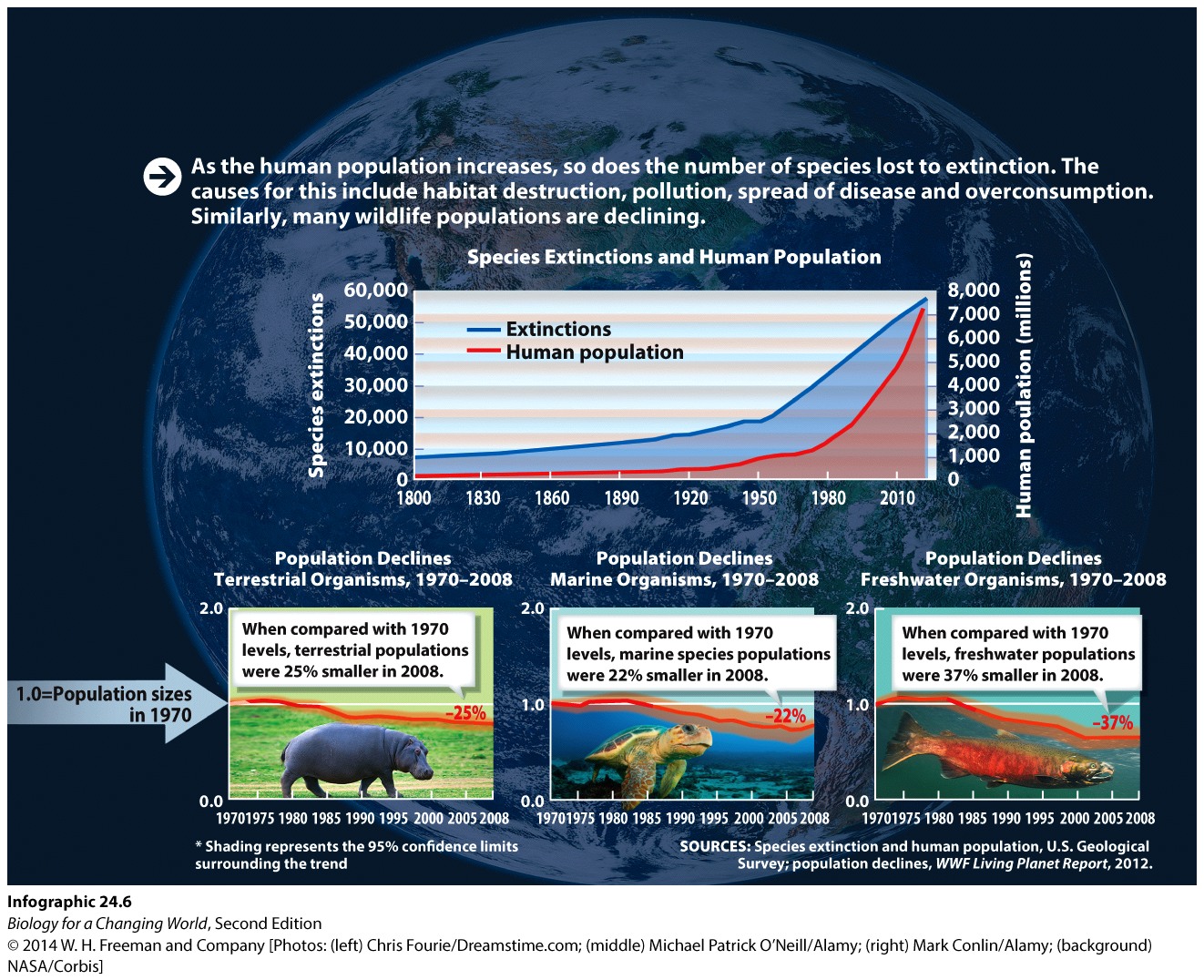
Examine the graphs in Infographic 24.6 and answer the following questions.
As the human population increased over the past few decades, what has happened to the number of extinctions globally?
24.
Why would an increase in human population lead to more species extinctions?
25.
Of the three groups of organisms, terrestrial, marine, and freshwater, why do you think that freshwater population sizes declined the most, at 37% from 1970?
Review Questions
26.
Which of the following actions does not contribute to an average person’s ecological footprint?
| A. |
| B. |
| C. |
| D. |
| E. |
27.
A region’s total potential resources and capacity to absorb wastes for supporting life is (are) its:
| A. |
| B. |
| C. |
| D. |
28.
It is possible to have an ecological footprint of zero.
| A. |
| B. |
29.
The only factor that determines a country’s ecological footprint is its population.
| A. |
| B. |
1.3 Driving Question 2:
Driving Question 2
What resources do humans rely on, and which of them are renewable?
Why should you care?
It should be easy to care about the fact that fossil fuels are nonrenewable because it affects your daily life in the form of high fuel prices. There are finite supplies of oil, natural gas, and coal, and we will eventually deplete them. As fossil fuels become scarcer, the more difficult and dangerous (both to people and the environment) they become to extract. Because of this, fossil fuels will become increasingly expensive.
Why should you care about renewable resources? That is a big question. Proponents of alternative energy sources and water conservation have tried for years to get people to be more concerned about renewable resources, but the world economy is based on nonrenewable resources. The increasing expense of using fossil fuels combined with concerns about ecological accidents, climate change, and national security are providing more incentives to develop renewable resources than ever before.
Although water is a renewable resource, we aren’t using it in a renewable fashion. We are drawing water from underground aquifers faster than they can refill; we are using treated water for all our needs, not just for cooking and drinking, and we are treating waste water and releasing it rather than recycling it.
Because we live on a planet that is mostly covered in water, it’s hard to imagine this resource becoming scarce, but only about 1% of the world’s water is fresh and unfrozen. Most of that is in underground aquifers, which are slow to refill, in some cases so slow as to be considered nonrenewable. It is very costly in terms of both money and energy to convert seawater for consumption. Irrigating arid land to grow crops can drain rivers and aquifers or lead to the accumulation of salts in the soil, leaving it infertile. As the standard of living rises in densely populated Asia, so does the demand for more polluting and resource-demanding foods, like meat and animal products in general. Animal agriculture uses several times more water than growing crops, so the demand for water is likely to outpace even the rise in population.
Water is not evenly distributed across the globe. Some parts of California, for example, use the Colorado River as a source of water. So much water is withdrawn from that river, actually, that its delta, where it empties into the sea of Cortez in Mexico, has dried up. So there are grounds for not only interstate disagreements but also international disagreements about how this water is used. The unequal distribution of water has the potential to become as politically charged as the unequal distribution of oil.
What should you know?
To fully answer this Driving Question, you should be able to:
- Explain the uses for the three main types of fossil fuels.
- Describe the environmental impact of fossil fuel use.
- Explain why the main types of alternative energies are not being used more widely now.
- Explain how water is a renewable resource.
- Explain how some consumption of water is unsustainable.
Infographic Focus
The infographics most pertinent to the Driving Question are 24.4 and 24.7 to 24.10.
Test Your Vocabulary
Choose the correct term for each of the following definitions:
| Term | Definition |
|---|---|
| Natural resources that are replenished after use as long as the rate of consumption does not exceed the rate of replacement. | |
| An underground layer of porous rock from which water can be drawn. | |
| Natural resources that cannot easily be replaced; fossil fuels are an example. |
Explain the uses for the three main types of fossil fuels.
30.
What are the uses for these types of fossil fuels?
- Coal
Where is coal found?
31.
How much of the United States’ energy comes from coal?
32.
How is coal used?
33.
- Natural Gas
Where is natural gas found?
34.
How much of the United States’ energy comes from natural gas?
35.
How is natural gas used?
36.
- Petroleum
Where are the United States’ oil supplies found?
37.
How much of the United States’ energy comes from oil?
38.
How is petroleum used?
39.
How much of the United States’ total energy comes from fossil fuels?
40.
Why is this a concern?
Describe the environmental impact of fossil fuel use.
41.
Complete the following table with information about the effects of extracting and using fossil fuels as an energy source.
| Ecological Impact of Fossil Fuels | ||
|---|---|---|
| Fossil Fuel | Extraction | Use for Energy |
| Coal |
Fill in: |
Fill in: |
| Natural gas |
Fill in: |
Fill in: |
| Petroleum |
Fill in: |
Fill in: |
| Ecological Impact of Fossil Fuels | ||
|---|---|---|
| Fossil Fuel | Extraction | Use for Energy |
| Coal | Mining damages habitats. | Releases greenhouse gases and pollutants. |
| Natural gas | Mining damages habitats. | Releases greenhouse gases. |
| Petroleum | Mining damages habitats. Oil spills can devastate ocean habitats and ocean-dependent economic activities, such as commercial fishing. | Releases greenhouse gases and fills landfills with nonbiodegradable plastics. |
Incorrect
Explain why the main types of alternative energies are not being used more widely now.
42.
For each of the following energy sources provide (1) a reason people have not been quick to adopt them and (2) an advantage of adopting them. (You will be asked to list their environmental impact later.)
| Type of Energy |
Percent of U.S. Energy Supply |
Why Don't We Use It? | Why Should We? |
| Solar |
Fill in: |
Fill in: |
Fill in: |
| Wind |
Fill in: |
Fill in: |
Fill in: |
| Nuclear |
Fill in: |
Fill in: |
Fill in: |
| Biomass |
Fill in: |
Fill in: |
Fill in: |
| Hydroelectric |
Fill in: |
Fill in: |
Fill in: |
| Geothermal |
Fill in: |
Fill in: |
Fill in: |
| Type of Energy |
Percent of U.S. Energy Supply |
Why Don't We Use It? | Why Should We? |
| Solar | 0.09 | Expensive to produce; manufacture of solar panels produces hazardous chemicals | No polluting emissions |
| Wind | 1.17 | Expensive to produce; takes up space. Manufacture of turbines uses hazardous chemicals. Turbines may interfere with bird species (e.g., turbine-caused death, interference in migratory patterns). | No polluting emissions |
| Nuclear | 8.00 | Expensive to design and build. Mining for uranium produces hazardous waste and destroys habitats. Waste from reactors is dangerous because it is radioactive and because it might be made into weapons. | Energy is harvested from the heat of the nuclear reaction. The reactions cause no emissions. |
| Biomass | 4.32 | Not enough is known about efficient production, and biomass crops can compete with food crops for inputs. | Fossil deposits of carbon are not used. |
| Hydroelectric | 3.15 | Dam building destroys habitats. | No emissions produced; expected to be able to fulfill half of Earth’s energy requirements. |
| Geothermal | 0.18 | Not enough is known about optimal techniques to harness energy from Earth’s heat. Also can be expensive, and pollutants can be released. | Potential for a sizable and sustainable resource. |
Incorrect
43.
Which alternative energy source is the most used today? Why do you think that is?
Nuclear energy is the most widely used alternative energy source today. This is more than likely because the infrastructure is already in place for nuclear plants and because individuals do not have to have their own reactor to use the energy produced from nuclear power.
Thought Question: In your opinion, what is probably the most important reason keeping us from using more renewable alternative energy sources versus fossil fuel?
Explain how water is a renewable resource.
44.
Explain the water cycle and how it makes water—at least in principle—a renewable resource.
Explain how some consumption of water is unsustainable.
45.
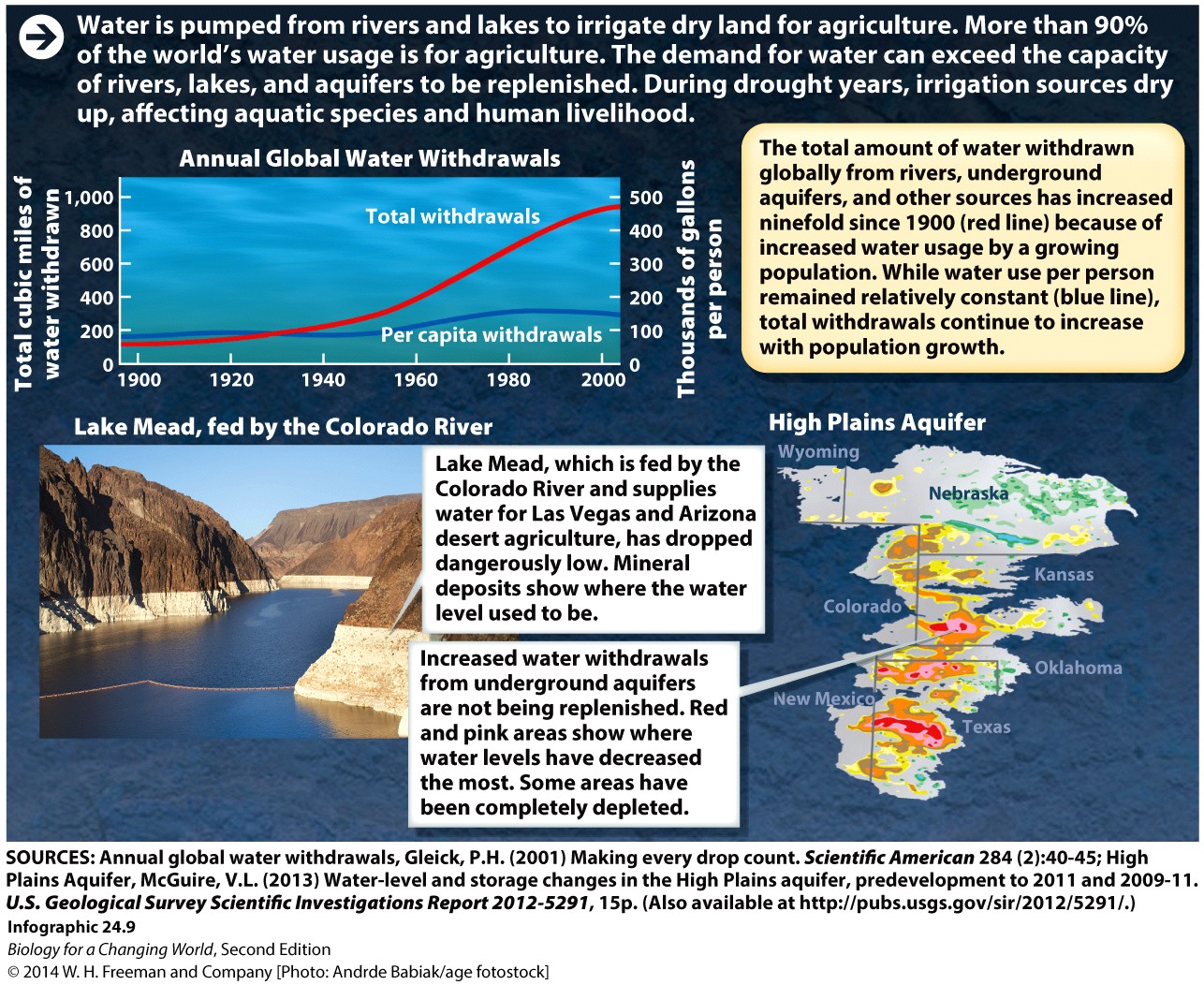
Examine the graph in Infographic 24.9 and answer the following questions:
What does the red line represent?
46.
What does the blue line represent?
47.
How has water use per person changed in the past few decades?
48.
Why has total water use changed?
49.
If water is a renewable resource, why is there concern over the growing demand for freshwater?
Review Questions
50.
An example of a nonrenewable resource is:
| A. |
| B. |
| C. |
| D. |
| E. |
51.
Oil is a product of the fossilized remains of organisms. Since organisms die all the time, oil should be considered a renewable resource.
| A. |
| B. |
52.
Why is the growing human demand for fossil fuels a problem in terms of Earth’s biocapacity?
| A. |
| B. |
| C. |
| D. |
53.
Besides greenhouse gas emissions, what are some negative effects of using nonrenewable resources for energy?
| A. |
| B. |
| C. |
| D. |
1.4 Driving Question 3:
Driving Question 3
What is sustainable living?
Why should you care?
By now, you have seen a lot of evidence supporting the need for living more sustainably. It’s hard to imagine that one person in 7 billion can make a difference, but one person working to live more sustainably can easily translate into more. Do you care about living sustainably?
Most urban planning and development (how the building of new housing, utility supplies, factories, and businesses is regulated) is dictated by monetary and political interests. A few areas, such as the city of Portland, Oregon, have comprehensive plans to be greener, such as restrictions on new building projects that encourage development of abandoned lots instead of productive land. Cities like Greenburg, Kansas have taken catastrophic events and used them as an opportunity to build a greener, more sustainable town, and they should be looked to as models for building a town with the environment in mind.
What should you know?
To fully answer this Driving Question, you should be able to:
- Describe the actions that people can take to reduce their ecological footprint and live more sustainably.
- Explain the impact of ecologically sustainable actions.
- Describe some of the sustainable features that could be incorporated into an ecologically friendly city.
Infographic Focus
The infographics most pertinent to the Driving Question are 24.6, 24.7, and 24.11.
Test Your Vocabulary
Choose the correct term for each of the following definitions:
| Term | Definition |
|---|---|
| A measure of how much land and water area is required to supply the resources an individual or a population consumes and to absorb the wastes it produces. | |
| The use of Earth’s resources in a way that will not permanently destroy or deplete them; living within the limits of Earth’s biocapacity. | |
| Raw materials that are obtained from Earth and are considered valuable even in their relatively unmodified natural form. | |
| Natural resources that are replenished as long as the rate of consumption does not exceed the rate of replacement. |
Describe the actions that people can take to reduce their ecological footprint and live more sustainably.
54.
List and describe five steps you can take to live more sustainably:
- Reduce vampire energy waste: to cut down on the amount of electricity used in your home, unplug appliances and other electronics when they are turned off.
- Eat less feedlot beef: eat lower on the food chain (i.e. plant-based foods) to reduce the amount of energy and resources used to produce your food.
- Recycle: recycle bottles, cans, newspapers, and so on so that energy and resources that go into production of new materials can be saved.
- Drive less and invest in fuel efficiency: drive a smaller, fuel efficient, or alternative-energy automobile. Use public transportation, walking, or biking to cut carbon dioxide emissions and dependency on fossil fuels.
- Reduce home water use: install faucet aerators and efficient showerheads to save, in the aggregate, millions of gallons of water each year. This will also cut down on carbon dioxide emissions from heated water.
55.
Which sustainable action will be easiest for you to do? Which would be the hardest?
Explain the impact of ecologically sustainable actions.
56.
Go back to your list of sustainable actions and list what environmental impact they have.
- Reduce vampire energy waste: Reduction of the amount of electricity used reduces greenhouse gas emissions. Depending on how your electricity is produced, habitats and other ecological factors may be spared.
- Eat less feedlot beef: this would reduce overall water consumption, since large animals drink a lot of water, and it takes water to grow their feed.
- Recycle: This cuts down on the raw materials and electricity needed to produce new products, which in turn cuts down on greenhouse gas emissions and habitat destruction.
- Drive less and invest in fuel efficiency: Cuts down on carbon dioxide emissions, habitat destruction, and general pollution both from the mining and burning of fossil fuels.
- Reduce home water use: In the aggregate, save millions of gallons of water being taken out of the water cycle and cut down on the carbon dioxide emissions from heating water.
Describe some of the sustainable features that could be incorporated into an ecologically friendly city.
57.
Explain how the following features help conserve resources in a city:
Trees planted along the streets:
Trees will use some of the carbon dioxide produced by car emissions. They will also help return water to the atmosphere and water cycle.
58.
Walking and bike paths connecting housing to schools and businesses:
Paths encourage walking and biking, which do not emit greenhouse gases or pollutants.
59.
Solar panels:
Solar collectors harness the zero-emission energy from the sun.
60.
Wind turbines:
They harness the zero-emission energy from the wind.
61.
Keeping buildings shorter: (Hint: Think of this in terms of the alternative energy sources mentioned above.)
Shorter buildings block less wind and sun so they can be used for turbines and solar panels.
Review Questions
62.
Which of the following can people do to decrease their ecological footprint? (Mark "yes" for all that apply.)
| a. Turn off electronics. | |
| b. Do not take long, hot showers. | |
| c. Use a bike for transportation whenever possible. | |
| d. Become a vegan or vegetarian. |
63.
Eating less beef would reduce the strain on freshwater supplies.
| A. |
| B. |
64.
Ecologically conscious changes made at an individual level can have an effect on the global community and environment.
| A. |
| B. |
Activity results are being submitted...